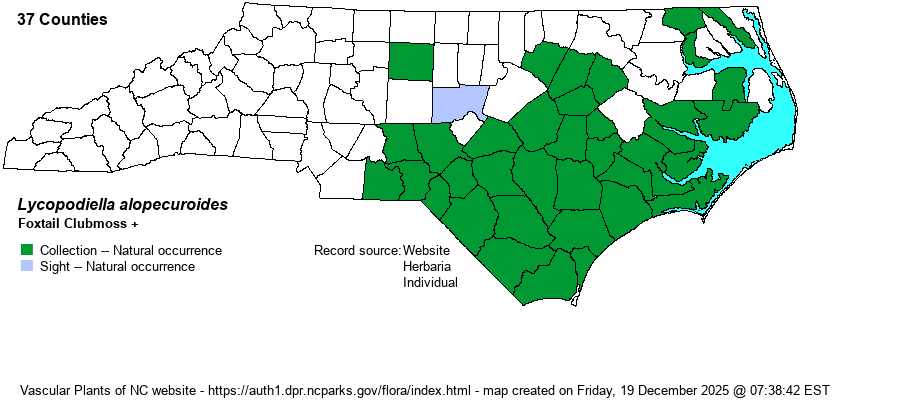| Author | (L.) Cranfill | |
| Distribution | Nearly throughout the Coastal Plain, though of spotty occurrence in the northern portion. Ranges sparsely into the eastern Piedmont, west to Guilford and Montgomery counties.
This is a Coastal Plain species, ranging from southern ME and southern OK, south to southern FL and eastern TX, mainly absent in the Mountains and Piedmont.
| |
| Abundance | Common in the southern half of the Coastal Plain, including the Sandhills. Fairly common in the central portion, but rare to uncommon and local in the northern portion. Very rare in the eastern Piedmont. | |
| Habitat | This is a characteristic species of moist to wet pinelands, especially in Longleaf Pine communities. It grows in pine savannas and flatwoods, seepages, streamhead pocosin margins, ditches, and wet to moist sandy places. It also may be found bordering beaver ponds and artificial lakes. | |
| Phenology | Fruits from July to September. | |
| Identification | This is a familiar clubmoss of Coastal Plain pinelands, growing as a horizontal stem with scattered vertical ones. The sterile stem makes low arches near the ground (not completely touching it), to about 1-1.5 feet long, not rooting; it is covered on all sides by numerous ranks of linear to needle-like leaves, each about 1/4-inch long, generally at an acute angle to the stem. The vertical stems are the fertile ones, each growing erectly to about 5-8 inches high, with similar but slightly longer leaves covering the stem, and the strobili are at the ends of the branches, each about 1.5-2 inches long and single. Three other Coastal Plain clubmosses are similar, with linear stems/branches. L. prostrata creeps along the ground with the whole stem touching the ground; and the leaves of the sterile (horizontal) stem are dimorphic -- the upper ones are shorter than the lateral ones, and thus the stem is not equally "wide" or rounded, when the leaves are included, appearing flattened (wider than high); the erect stems are few in number, normally well away from the tip of the stem and unequal in height. Also, these lateral leaves tend to be more spreading than the more ascending leaves in L. alopecuroides, and thus the width of the stem (with leaves) averages 12-19 mm (about 2/3-inch) wide, as opposed to about 8-11 mm (2/5-inch) wide in L. alopecuroides. L. appressa has the fertile leaves (on the vertical stems) rather short and appressed, and the strobili are narrow -- only about 3-6 mm versus 10-20 mm in these other two species. Pseudolycopodiella caroliniana, formerly in the same genus as these others, differs by the relatively few leaves on the vertical (fertile) stems, and these are whorled -- resulting in a very slender "stalk" that almost appears free of leaves; also, the leaves on the sterile (horizontal) stems are wider and occur as a flattened spray rather than the more rounded array of leaves in the others. | |
| Taxonomic Comments | This species and L. prostrata are often included within the same species; this was named as Lycopodium alopecuroides in older references.
| |
| Other Common Name(s) | Foxtail Bog Clubmoss | |
| State Rank | S4 [S5] | |
| Global Rank | G5 | |
| State Status | | |
| US Status | | |
| USACE-agcp | OBL link |
| USACE-emp | FACW link |

